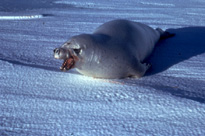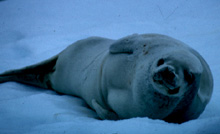Crabeater Seal
(Lobodon carcinophagus)
IUCN STATUS (2010) -LEAST CONCERN
| Distribution and Numbers Crabeater seals are the most numerous pinniped species in the world and are curiously named since their major prey is not crabs but Antarctic krill. They are found throughout the pack ice that surrounds the Antarctic continent, often in more concentrated numbers around the edges. It is difficult to determine the true size of the crabeater seal population as only limited counts have been carried out due to the problems of surveying in the inhospitable Antarctic climate. It is generally believed that there are around 15 million crabeater seals but early results from the multinational Antarctic Pack Ice Seal Survey which took place in 1999-2000 appear to indicate that numbers of the seals are much less than previously thought. The distribution of crabeater seals is generally dependent on the seasonal movement of the pack ice and they are also found elsewhere in the Southern Ocean and near subantarctic islands. Wandering crabeater seals have been recorded in South Africa, South America, New Zealand and Australia. |
 Photo: Lloyd Lowry / Kathy Frost, Alaska Department of Fish and Game |
| Status As with other seals of the Antarctic pack ice, crabeater seals have largely been protected from commercial hunting due to their inaccessibility and the high cost of operating in the area. All killing of seals in the Antarctic region is regulated by the Antarctic Treaty and the Convention for the Conservation of Antarctic Seals (CCAS). A Soviet Union commercial sealing expedition however killed 4,000 crabeater seals in 1986-1987. A plan by Norwegian scientists to kill 20 crabeater seals, as well as 60 other seals, in the summer of 2000-2001 for research into environmental contaminants was cancelled after the Norwegian government rejected the plan. Several environmental organisations had vigorously opposed the plan, questioning its necessity and also its appropriateness given the option of alternative non-lethal sampling techniques. |
 Photo: Michael Bryden, University of Sydney |
The species' heavy dependence on krill may cause it problems. As populations of marine mammals that were previously hunted in the Southern Ocean, e.g. cetaceans, recover to pre-exploitation levels then competition for krill will increase. There is also a fishery for krill around Antarctica and some krill-fishing nations are seeking an increase in the quotas. In 1995 there was a 46% increase in the fishery and new techniques have recently been developed to convert krill into a supplement for fish feed. In January 1998 the Environmental Protection Protocol to the Antarctic Treaty was ratified, implementing environmental measures such as the banning of mining and oil drilling in Antarctica for at least 50 years and the banning of refuse disposal and the use of pesticides in the region. |
| A report produced in 1999 expressed concern that warming global temperatures are impacting ocean ecosystems much earlier and far more broadly than many experts anticipated, and that if global warming continues then species that depend on the diminishing pack ice, such as crabeater seals, will be threatened by decreased habitat and food supply. |
| Lifestyle Crabeater seals usually form family groups every spring in the pack ice region. These groups consist of a male, female and pup who normally stay together until the pup has been weaned, roughly estimated to be about 14-21 days after its birth. The male is very aggressive towards other males who take an interest in the female during this time. Pups are born mainly in September and October with a light grey coat that they moult about two weeks afterwards. Breeding takes place after the pup has been weaned. At various times, especially during the breeding season, groups of juvenile and non-breeding seals may congregate on the ice. Crabeater seals moult in January and February, their new fur being dark grey on top and silver-grey underneath, the whole coat becoming lighter as the months pass. Most crabeater seals have obvious scars, both from predator attacks and as a result of fighting during the breeding season. |
| Individual seals have been known to travel very long distances around Antarctica and also sometimes to wander quite far inland. Crabeater seals feed almost entirely on krill, small shrimp-like creatures, near the Antarctic peninsula but are known to have a more opportunistic and varied diet in other regions. The seals have special lobed teeth that help them to sieve the krill out of the seawater. They seem to prefer diving and feeding at night, mostly at dusk and dawn, with shallow dives of less than 40m lasting less than 5 minutes. Satellite tracking in one recent research study showed that the seals spent almost all of the night in the water foraging and that most of them were hauled out on the ice and resting by midday. Crabeater seal pups and juveniles are heavily preyed on by leopard seals, especially newly-weaned pups during the spring and summer, and this predation is a key influence on the lifestyle and habits of the species. Killer whales also prey on crabeater seals of all ages. |
| Statistics There is little difference in size between the sexes, male and female adults measuring 2.2-2.6m in length and weighing approximately 220kg, although the females are usually slightly heavier. Pups are born about 1.2m in length and weighing an average of 30kg. Both females and males achieve sexual maturity at 2.5-6 years, the actual age possibly being dependent on food abundance. Crabeater seals have been known to dive to depths of up to 430m and for periods in excess of 10 minutes. They can live to about 40 years of age but the average lifespan is 20 years. |
 Photo: Michael Bryden, University of Sydney |
